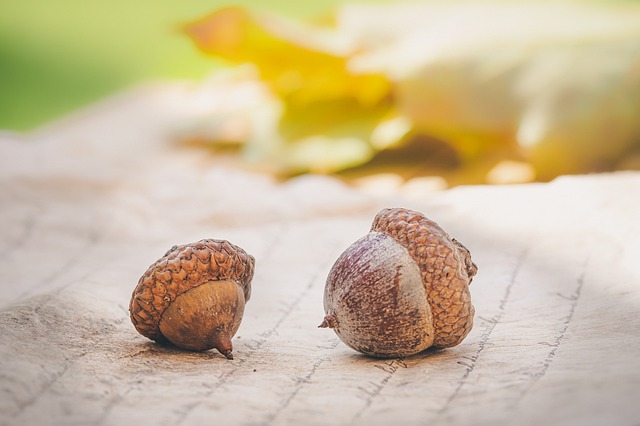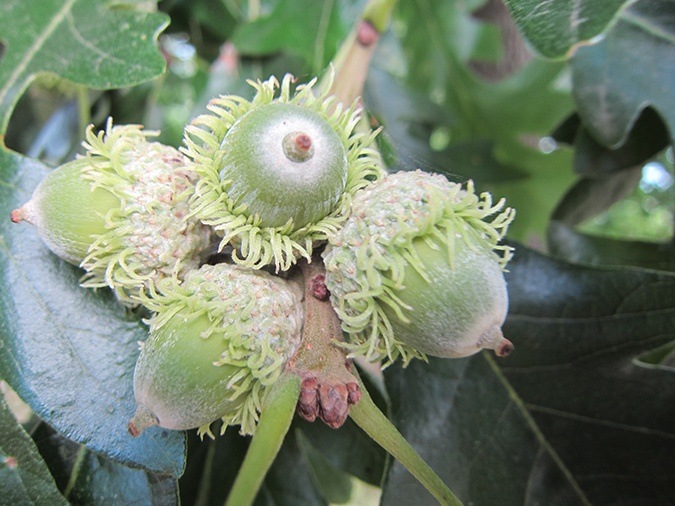I am really into free wild food—especially food that is easy to find, harvest, and process. If it is calorie-dense and full of nutrition, that’s a huge bonus. Oh, and it needs to taste good, too!
Many wild foods are … well, how can I say this nicely? Uh, they are edible, but not palatable. They taste too “different” for most folks.
And a lot of wild foods just don’t come in any kind of quantity worth going after.
Or they are difficult to get to.
Or they take skill to identify.
The vast majority of people just aren’t into harvesting wild foods due to all the many problems that can go along with doing so.
But there is one really awesome exception that you should know about.
So what is the ideal wild food for beginning foragers?
Best Free Wild Food For Beginning Foragers
Acorns.
Yup, the nuts that most oak trees produce. And gosh, there are oak trees throughout most of North America. I doubt you’ll have any problems with identifying oaks, or mistaking them for anything poisonous. (And read further down to learn about two helpful resources on how to get started, including information on what oaks are best and how to process them.)
You May Also Enjoy:
I’ve been playing around with harvesting and processing acorns for many years. And I’ve had some amazingly good, tasty successes.
(Oh, I’ve had a few disasters, too. But, generally, it’s been wonderful.)
For example, pancakes made with acorn meal are really delicious. They have a nutty, wholesome flavor. It is what I always wanted from pancakes. There is this richness and satisfaction that you can only get from high-quality, nutrient-dense foods.
Plus, you feel full for a good long time. You won’t have that empty, hungry feeling that refined-flour pancakes disappoint with.
I don’t consider myself an expert. But it really doesn’t take that much to process acorns. It is one of the easier wild foods to get started with.
Most of my batches of acorns so far have been small-scale, involving just myself.
Like most of the skills I am working on, I try to do enough each year to keep the knowledge alive and to learn just a bit more.
Best Resources For Beginning Wild Food Foragers
If you’re interested in learning more about this skill, too, check out these two great resources about processing and eating acorns:
- The first is this free article on processing acorns, which includes some recipes that use acorns:
“How to Process and Cook With Acorns” - And the second source is my absolute favorite book on acorns (and I’ve read a lot of books):
“It Will Live Forever” by Beverly R. Ortiz
(Actually, most of the book is what Beverly learned, or was told, about acorns by Julia F. Parker.)
The description on the back cover really tells it all:
For centuries, the Yosemite Indians have been gathering acorns, drying and storing them, and pounding, winnowing, sifting, leaching, and cooking them in a highly evolved, elegant, and skillful process. “It Will Live Forever” looks at Julia Parker, a Kashaya Pomo woman who married into the Yosemite Miwok tribe and is still practicing this traditional art as Indian women have done for generations.
“It Will Live Forever” remains the only source of intimate descriptions of one of the most vital aspects of traditional California Indian life.
These are great resources to help you get started. I hope you enjoy them!
What Do You Think?
If you’ve been eating acorns for a while, leave me a comment to let me know your experiences!
_______________
Psst! Our Lawyer Wants You to Read This Big, Bad Medical Disclaimer –> The contents of this article, made available via The Grow Network (TGN), are for informational purposes only and do not constitute medical advice; the content is not intended to be a substitute for professional medical advice, diagnosis, or treatment. Always seek the advice of a qualified health care provider with any questions you may have regarding a medical condition. If you think you may be suffering from any medical condition, you should seek immediate medical attention. You should never delay seeking medical advice, disregard medical advice, or discontinue medical treatment because of information provided by TGN. Reliance on any information provided by this article is solely at your own risk. And, of course, never eat a wild plant without first checking with a local expert.
Marjory Wildcraft is the founder of The Grow Network, which is a community of people focused on modern self-sufficient living. She has been featured by National Geographic as an expert in off-grid living, she hosted the Mother Earth News Online Homesteading Summit, and she is listed in Who’s Who in America for having inspired hundreds of thousands of backyard gardens. Marjory was the focus of an article that won Reuter’s Food Sustainability Media Award, and she recently authored The Grow System: The Essential Guide to Modern Self-Sufficient Living—From Growing Food to Making Medicine.









COMMENTS(0)
in theory, it is a great idea. However, I live in an urban environment and have no oak trees on my property. Since I do not know what pesticides or vegetation control substances might have been used by the owners of property around me, I would never presume that any acorns near me would be safe to eat. In the metropolitan area in which I live, homeowners routinely to use said products.
Hi Kathleen, yes that is a good concern. Any chance of visiting public lands that would allow collection? Or a friend with property?
Hi Marjory!
Funny, I read this shortly after pouring off the first soaking water of my batch of acorns. This is my first attempt at making acorn meal, or using acorns in any way for food. Like you, we have a bumper crop of them this year! I hate to see good nutrition go to waste, so I gathered a bag full ( took about 15 min, not counting talking to the neighbor who drove by and wondered WHAT I was doing!).
Acorns seem to suffer a stigma as “poverty food”, but I don’t care… I think we all ought to be more mindful about and thankful for what is out there for us to enjoy.
I took a small portion and plan to try to sprout these. The rest I hope to process into flour. I will let you know!
I did learn one tidbit… The smaller the ‘”cap” on top, the less tannins the acorns contain. Thats what makes them too bitter to eat without leaching, and I’m fortunate to have some variety of white oak which has a very small cap.
Funny, I was planning on making pancakes too!
Oh Deb, thanks for the tip about smaller caps. I had heard and noticed that the white oaks do have less tannin, but hadn’t made the correlation about caps.
Hmm, I had never heard ‘poverty food’ and acorns together. Actually I had never heard of anyone eating acorns except indigenous people.
Hah, just proves the general insanity. LOL
We have a beautiful red oak on our property and I’ve been meaning to try using the acorns for some time. I’ve been gathering acorns as I rake this year and have quite a few now, so I appreciate the inspiration and links to instructions and recipes!
And yes, my tree book refers to white oak acorns as “sweet acorns” not requiring the leaching, or as much, as from other species.
I remember gathering acorns as a child, put them in a paper bag in my bedroom, forgot they were there and about a month later the bag was moving and filled with worms. My dear grandfather had to clean it up before my mother saw it. Should I be concerned about these worms in the acorns I gather to grind?
Hi Anne – A lot of times, if you look closely you can see which acorns have a worm in them – they leave a tiny hole behind when they eat their way in. There’s a bit more information in this article – Acorns – A Major North American Food Source – about picking the acorns that fell from the tree with their caps still intact. That will help you start with worm-less acorns, and I think if you leach them and grind/mill them – you shouldn’t have any worms left by the end of that process.
Actually, the hole is generally where a worm has already tunneled its way OUT, not in, but yes you should skip any with holes. We’ve found that you really need to gather them early in the season if you don’t want weevils. If you gather early, you may find a handful in a big bag of acorns. Once they’ve been on the ground a while you’ll end up with a bag of weevils. Ew! And yes, go for the ones that still have the cap.
You also need to do “sink or float” with them first. Put them all in a pail of cold water and toss any that float. Those have weevils. Keep the sinkers and you’re likely to find very few.
I have a beautiful oak in my yard and would love to try this, but I can’t bring myself to steal from the squirrels. I did take a few, but I am hoping to start new trees. Oaks are uncommon to the area I currently live – Central Alberta.
I’m sure they won’t mind too much if you took some, you can always go to the local feed store and purchase cracked corn or wheat and leave it for the squirrels, it makes a nice “trade off”.